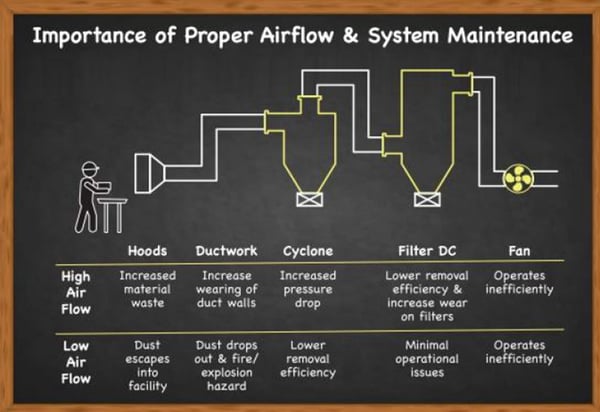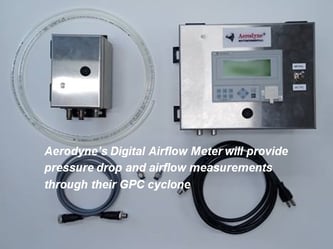Dust collection systems pick up dust generated by process equipment and move it away for disposal or to be recycled. They use hoods to gather the air around the dust generation equipment. The dusty air is then sent to the dust collection equipment through ductwork. The dust collection equipment often consists of a pre-filter to help collect the dust followed by the main dust collector. An exhaust fan is often at the end and it powers the system by pulling the air through each of these components.

Cyclones
Cyclone dust collectors are very dependent on the airflow that is going through them. Cyclone pressure drops are based on many factors, but the two most important are the geometry of the cyclone and the volumetric airflow through the cyclone. The pressure drop formula of a cyclone has the square of the volumetric airflow through the cyclone. So, doubling the airflow will quadruple the pressure drop (2x ACFM leads to 4x dp). If your airflow changes through the system, the pressure drop through your cyclone can fluctuate.
Since dust collection system static requirements are all related, the exhaust fan will find its operating condition naturally. However, if the airflow decreases, then the removal efficiency of cyclone will decrease too. This means the cyclone will remove less of the finer dust particles, thereby sending them on to the filters. That will cause greater dust loading for the filters, which could increase the frequency of cleaning (more plant air usage, greater filter wear, etc.) and decrease the lifespan of the filters.
Filter Collectors
Filter collectors would actually benefit from lower airflow. The lower airflow would decrease the air to cloth ratio, which can extend the life of the filters. However, as described in the rest of this paper, the overall performance of the dust collector system will decrease. And if the system has a cyclone dust collector, the benefits gained by a lower a/c ratio could be counteracted by higher dust loading coming through the cyclone.
Higher airflow will increase the air to cloth ratio and could put more strain on the filters. The velocity of the air going through the filter could increase enough that holes in the filters could develop, thereby causing dust to bypass the filters.
However, filter collectors have a pretty good range of airflows they can handle without significant effect on the system. Unlike cyclones, the pressure drop in a filter is based less on airflow and more on the filter pack on them.
To improve efficiency and safety, there is no substitute for an on-site inspection by an experienced expert. Click below to start with a free 20-minute phone consultation by clicking the button.

